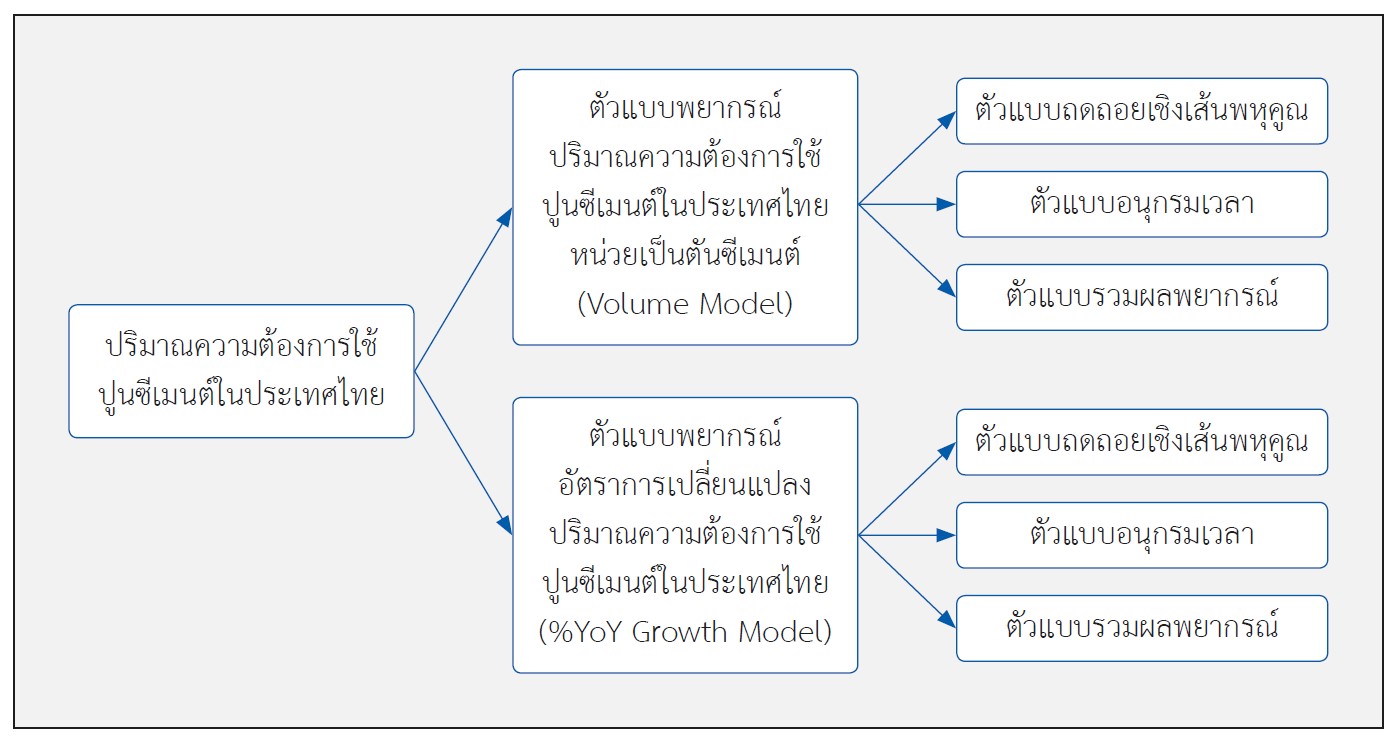Forcasting Of Cement Consumption In Thailand
Keywords:
Forecasting, Cement, Consumption, Regression Analysis, Combined ForecastsAbstract
This research is an applied research designed to determine macroeconomic and demographic impacts on Thai’s cement consumption to develop 5 years-forecasting models for both volume and growth in Thailand’s demand for cement. Several techniques including Multiple Linear Regression, time-series models such as Simple and Holt’s Exponential Smoothing, ARIMA, and combined-forecast models were developed and examined to attain forecasting accuracy. The results showed that the combined–forecast model was the most accurate model according to its lowest RMSE for both volume and growth. Based on the results, the total cement consumption in Thai market in 2021 should fall between 36,223 and 42,082 thousand tons. However, the volume model resulted in 753 thousand tons of RMSE, lower than 2,099 thousand tons of RMSE in the growth model.
References
Box, G. and Jenkins, G. (1970). Time Series Analysis: Forecasting and Control. Holden-Day, San Francisco.
Cao, Z., Shen, L., Liu, L. & Zhong S. (2016). Analysis on major drivers of cement consumption during the urbanization process in China. Journal of Cleaner Production, 133, 304-313.
Chambers, J. C., & Mullick, S. K., Smith, D. D. (July 1971). How to Choose the Right Forecasting Technique. Harvard Business Review.
Chungcharoen, E. (2017). Business Forecasting. Thammasat University Press.
Davidson, E. (June 2014). Defining the Trend: Cement consumption versus Gross Domestic Product. Global Cement Magazine.
Dobrotă, G., & Căruntu, C. (2013). The Analysis of the Correlation between the Economic Growth and Crude Steel Production in the Period 1991-2011. Metalurgija, 425-428.
Holt, C.C. (1957). Forecasting Seasonals and Trends by Exponentially Weighted Moving Averages. ONR Memorandum, 52, Carnegie Institute of Technology, Pittsburgh.
Li, H. (2014). The Effects of Demographics on the Real Estate Market in the United States and China. Honors College Theses. 137.
Li, N., Ma, D., & Chen, W. (2015). Projection of Cement Demand and Analysis of the Impacts of Carbon Tax on Cement Industry in China. Energy Procedia, 75, 1766-1771.
Lim, J., & Lee, J. (2013). Demographic changes and housing demands by scenarios with ASFRs. International Journal of Housing Markets and Analysis, 6(3), 317-340.
Low, S. (1983). The Global Cement Industry, Singapore: Singapore University Press.
Mankiw, N. G., & Weil, D. N. (1989). The Baby Boom, The Baby Bust, and The Housing Market. Regional Science and Urban Economics, 19, 235-258.
Nelson, C.R. (1984). A Benchmark for the Accuracy of Econometric Forecasts of GNP. Business Economics, 19(3), 52-58.
Noppawong, H. (2009). Cement Consumption in Thailand Construction Industry (Dissertation). School of Development Economics, National Institute of Development Administration.
Office of Industrial Economics. (2007). Thailand Cement Industry: Bright Future?
Wei, X. (2009). Regression-Based Forecast Combination Methods. Journal of Economic Forecasting, 4, 5-18
Yang, Y. (2004), Combining Forecasting Procedures: Some Theoretical Results, Econometric Theory, 20, 176-222.

Downloads
Published
How to Cite
Issue
Section
License
Copyright (c) 2020 https://creativecommons.org/licenses/by-nc-nd/4.0/

This work is licensed under a Creative Commons Attribution-NonCommercial-NoDerivatives 4.0 International License.



